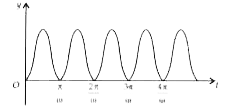The function sin2(ωt) represents
a periodic, but not simple harmonic motion with period 2π/ω
a periodic, but not simple harmonic motion with period π/ω
a simple harmonic motion with a period 2π/ω
a simple harmonic motion with a period π/ω
The correct Answer is:B
Here, y=sin2ωt

dydt=2ωsinωt−ωsin2ωt
d2ydt2=2ω2cos2ωt
For SHM, d2ydt2∝−y
Hence, function is not SHM, but periodic.
From the y-t graph, time period, T=πω
Topper's Solved these Questions
- BOOK - MTG-WBJEECHAPTER - OSCILLATIONS AND WAVESEXERCISE - WB JEE WORKOUT (CATEGORY 2: SINGLE OPTION CORRECT TYPE 2 MARKS)15videos
OSCILLATIONS AND WAVES
- BOOK - MTG-WBJEECHAPTER - OSCILLATIONS AND WAVESEXERCISE - WB JEE WORKOUT (CATEGORY 3: ONE OR MORE THAN ONE OPTION CORRECT TYPE (2 MARKS))10videos
OSCILLATIONS AND WAVES
- BOOK - MTG-WBJEECHAPTER - NUCLEAR PHYSICEXERCISE - WB JEE PREVIOUS YEARS QUESTIONS5videos
NUCLEAR PHYSIC
- BOOK - MTG-WBJEECHAPTER - PARTICLE NATURE OF LIGHT AND WAVE PARTICLE DUALISMEXERCISE - WB JEE PREVIOUS YEARS QUESTIONS15videos
PARTICLE NATURE OF LIGHT AND WAVE PARTICLE DUALISM
Similar Questions
Knowledge Check
- Question 1 - Select One
The equation y=Asin2(kx−ωt) represents a wave with
Aamplitude A, frequency ω/2πBamplitude A/2, frequency of ωπCamplitude 2A, frequency ω/4πDit does not represent a wave motion - Question 2 - Select One
Equation y=y0sin(Kx+ωt) represents a wave :-
ATravelling in y-directionBTravelling in negative y-directionCTravelling in x-directionDTravelling in negative x-direction - Question 3 - Select One or More
The function x=Asin2(ω)t+Bcos2(ω)t+Csin(ω)tcos(ω)t represent (SHM) for which of the option(s).
Afor all value of A,BandC(C≠0).BA = B, C = 2 BCA = - B, C = 2 BDA = B, C = 0
Find time period of the function, y=sinωt+sin2ωt+sin3ωt
View SolutionWhich of the following functions of time represents (a) simple harmonic motion and (b) periodic motion? Given the period for each case.
i. Sinωt−cosωt ii. Sin2ωtView SolutionWhat is the time period for the function f(t)=sinωt+cosωt may represent the simple harmonic motion ?
View SolutionIn a wave motion y=sin(kx−ωt),y can represent :-
View SolutionEquations y=2Acos2ωtandy=A(sinωt+√3cosωt) represent the motion of two particles.
View Solution

